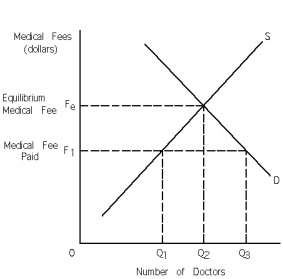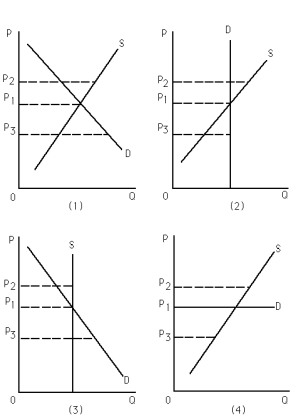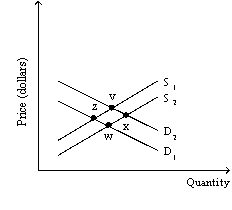A) more;lower
B) more;higher
C) less;higher
D) less;lower
E) b and d
Correct Answer

verified
Correct Answer
verified
Multiple Choice
Which of the following is an example of a service?
A) medical care
B) dental care
C) a psychology lecture
D) a television set
E) a,b and c
Correct Answer

verified
Correct Answer
verified
Multiple Choice
The fundamental reason why most supply curves are upward sloping is that
A) consumers substitute lower-priced goods for higher-priced goods.
B) the quantity supplied increases as more firms enter the market.
C) a higher price never reduces quantity supplied by enough to lower total revenue and so higher production is motivated.
D) higher production raises the opportunity costs of production and so price must rise to induce more output.
Correct Answer

verified
Correct Answer
verified
Multiple Choice
Exhibit 3-14
 -Refer to Exhibit 3-14.At a price of $12,there is a ____________ unit ____________ of good X.
-Refer to Exhibit 3-14.At a price of $12,there is a ____________ unit ____________ of good X.
A) 195;shortage
B) 230;shortage
C) 195;surplus
D) 230;surplus
E) 180;shortage
Correct Answer

verified
Correct Answer
verified
Multiple Choice
An "increase in demand" means that
A) the demand curve has shifted to the left.
B) price has declined and consumers want to purchase more of the good.
C) the demand curve has shifted to the right.
D) the price of the good can be expected to decline,assuming supply stays constant.
Correct Answer

verified
Correct Answer
verified
Multiple Choice
Exhibit 3-15  -Refer to Exhibit 3-15.In Exhibit 3-15,
-Refer to Exhibit 3-15.In Exhibit 3-15,
A) there is a shortage of doctors at fee F1.
B) there is a surplus of doctors at fee F1.
C) Q3 doctors are employed at fee F1.
D) Q2 doctors are employed at fee F1.
E) both a and c
Correct Answer

verified
Correct Answer
verified
Multiple Choice
An increase in the number of sellers will,ceteris paribus,
A) increase equilibrium price and quantity.
B) increase equilibrium price and decrease equilibrium quantity.
C) decrease equilibrium price and increase equilibrium quantity.
D) decrease equilibrium price and quantity.
E) increase demand.
Correct Answer

verified
Correct Answer
verified
Multiple Choice
A "decrease in demand" means that
A) the demand curve has shifted to the left.
B) price has declined and consumers want to purchase more of the good.
C) the demand curve has shifted to the right.
D) the price of the good can be expected to decline,assuming supply stays constant.
Correct Answer

verified
Correct Answer
verified
Multiple Choice
In the supply-and-demand diagram of the market for peanut butter,the equilibrium point has moved up and to the right.What could have caused this?
A) a fall in the price of peanuts
B) a rise in the price of peanuts
C) a rise in income,assuming that peanut butter is an inferior good
D) a shift in preferences toward peanut butter
E) none of the above
Correct Answer

verified
Correct Answer
verified
Multiple Choice
Resource X is necessary to the production of good Y.If the price of resource X rises,the _____________ curve for good Y will shift ____________ resulting in a(n) _____________ in the equilibrium price of Y and a(n) ____________ in the equilibrium quantity of Y.
A) supply;rightward;decrease;increase.
B) demand;leftward;decrease;decrease
C) demand;rightward;increase;increase
D) supply;leftward;increase;decrease
E) supply;leftward;increase;increase
Correct Answer

verified
Correct Answer
verified
Multiple Choice
Exhibit 3-16  -Refer to Exhibit 3-16.If there are empty seats for a basketball game at the price P*,the situation is best depicted on graph
-Refer to Exhibit 3-16.If there are empty seats for a basketball game at the price P*,the situation is best depicted on graph
A) (1) ,with P* = P1.
B) (2) ,with P* = P3.
C) (3) ,with P* = P2.
D) (3) ,with P* = P3.
E) (4) ,with P* = P1.
Correct Answer

verified
Correct Answer
verified
Multiple Choice
Exhibit 3-12
 Assume that Aline,Bentley,Calvin,and Daniel are the only sellers in this market.
-Refer to Exhibit 3-12.Each individual seller's supply curve is ________________ sloping and the market supply curve is _________________ sloping.
Assume that Aline,Bentley,Calvin,and Daniel are the only sellers in this market.
-Refer to Exhibit 3-12.Each individual seller's supply curve is ________________ sloping and the market supply curve is _________________ sloping.
A) upward;also upward
B) downward;also downward
C) upward;downward
D) downward;upward
Correct Answer

verified
Correct Answer
verified
Multiple Choice
Exhibit 3-14
 -Refer to Exhibit 3-14.At a price of $11,there is a ____________ unit ____________ of good X.
-Refer to Exhibit 3-14.At a price of $11,there is a ____________ unit ____________ of good X.
A) 290;shortage
B) 215;shortage
C) 40;surplus
D) 290;surplus
E) 230;shortage
Correct Answer

verified
Correct Answer
verified
Multiple Choice
Exhibit 3-5  -Refer to Exhibit 3-5.In the market shown,a rightward shift in supply from S1 to S2 could have been caused by
-Refer to Exhibit 3-5.In the market shown,a rightward shift in supply from S1 to S2 could have been caused by
A) a decline in the number of buyers in the market.
B) a decline in the price of a substitute good.
C) a decrease in income (assuming the good is a normal good) .
D) the granting of a subsidy to the producer.
E) none of the above
Correct Answer

verified
Correct Answer
verified
Multiple Choice
If price is on the vertical axis and quantity demanded is on the horizontal axis,why is a demand curve downward sloping (left to right) ?
A) Because a demand curve is the graphical representation of the law of demand,which specifies an inverse relationship between price and supply,ceteris paribus.
B) Because a demand curve is the graphical representation of the law of demand,which specifies a direct relationship between price and quantity supplied,ceteris paribus.
C) Because a demand curve is the graphical representation of the law of demand,which specifies an inverse relationship between price and demand,ceteris paribus.
D) Because a demand curve is the graphical representation of the law of demand,which specifies a direct relationship between price and demand,ceteris paribus.
E) Because a demand curve is the graphical representation of the law of demand,which specifies an inverse relationship between price and quantity demanded,ceteris paribus.
Correct Answer

verified
Correct Answer
verified
Multiple Choice
A vertical supply curve represents:
A) an inverse relationship between price and quantity supplied.
B) an independent relationship between price and quantity supplied.
C) an independent relationship between price and supply.
D) a direct relationship between price and quantity supplied.
E) a direct relationship between price and supply.
Correct Answer

verified
Correct Answer
verified
Multiple Choice
One can determine the consumers' surplus if the _______________ is known
A) tax paid
B) maximum buying price
C) price paid
D) b and c
E) a and b
Correct Answer

verified
Correct Answer
verified
True/False
If the quantity demanded of good X is greater than the quantity supplied of good X,then the market for good X is in disequilibrium.
Correct Answer

verified
Correct Answer
verified
Multiple Choice
One can determine producers' surplus if the minimum selling price and the _____________ is known.
A) price received
B) price paid
C) tax paid
D) tax received
E) a and c
Correct Answer

verified
Correct Answer
verified
Multiple Choice
Which of the following pairs of goods would be most likely to be complements?
A) butter and margarine.
B) peanuts and peanut butter.
C) DVD's and DVD players.
D) hiking boots and tennis shoes.
E) All of the above
Correct Answer

verified
Correct Answer
verified
Showing 61 - 80 of 227
Related Exams